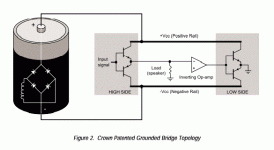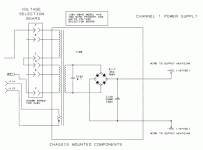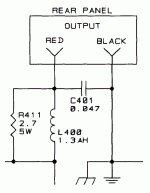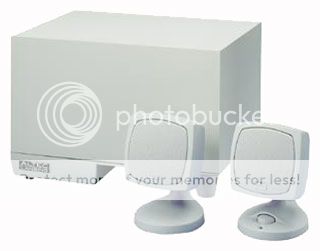Amplifiers like this sound good, even when the peaks are driven 6dB into clipping. You won't even notice it unless you're watching the IOC indicators. Comapre this to a switching amp that sounds like a mistuned FM radio station when driven slightly into clip, or your average home stereo which is somewhere in between.
The more average power you can get before it goes to hell in a handbasket, the more 'slam' you're going to get.
Doesn't that take us back again to the question of the output power capability which doesn't explain much? except in pro-audio where one is obviously fully exploiting the nominal power capacity of an amp.
Ok, the Crown exceeds 1KW (4ohm). But let's take for comparison a Hafler 9505 rated 250W with strong class A polarisation on the first few watts, a big transformer, very big caps etc. In home hifi use with both these amps, I am far from the max power. But at the same sound level, the Crown still remains unique in the low end department: you hear and you feel distinctively a kick drum, a double bass attack, you feel a punch in the chest and a succession of attacks is restituted realistically without a "mumbling" mix of bass tones etc. (that's what I mean by "slam").
But at the same sound level...
How did you determine this? Did you compare level-matched?
How important is damping factor really? The amount of damping is limited by the resistance of the voice coil. You might think that an amp with a damping factor of 1000 damps the speaker 10 times more than one with a DF of 100. But actually it only damps it 1% more.
Crown was a company with sound engineering principles. If they built a "Studio Reference" amp they wouldn't tweak the circuit to add extra slam, they would make it accurate. So I don't see where the slam is coming from. I can see where it came from in live sound as the Macro-Tech amps were hugely powerful and would probably kick out more undistorted bass energy than their competitors.
One thing to ponder though, when high powered amps are used with sensitive speakers at home listening levels, weird things related to crossover distortion can happen. The quality of the "first watt" varies greatly between amps and the spec sheets do a great job of hiding this.
Crown was a company with sound engineering principles. If they built a "Studio Reference" amp they wouldn't tweak the circuit to add extra slam, they would make it accurate. So I don't see where the slam is coming from. I can see where it came from in live sound as the Macro-Tech amps were hugely powerful and would probably kick out more undistorted bass energy than their competitors.
One thing to ponder though, when high powered amps are used with sensitive speakers at home listening levels, weird things related to crossover distortion can happen. The quality of the "first watt" varies greatly between amps and the spec sheets do a great job of hiding this.
Last edited:
Micing, mixing and EQ techniques could also affect the perceived "slam" factor. I've seen and heard it... Person A's mix at our church is lifeless and dead... the players on stage are rocking it out, and the sound coming from the speakers are Mehhhhh... Person B's mix is alive and "slamming"... same set of equipment, same players, same instruments. Using all Crown amps.. several Crown Macro and CTS models.
Member
Joined 2009
Paid Member
The Macro Reference has an extra loop feedback path, and an even higher DF than the Macro Tech.
The Macro Tech line comes in various power levels, from about 300w @ 8ohms up to a couple of kW @ 8 ohms. And they can be bridged.
Otoh, there are inexpensive amps like the Behringer iNuke that sports extremely high power. So, is it the power?
Why does a Phase Linear sound like a Phase Linear? They do have a certain "sound".
I'm going to suggest that the Macro Tech "sounds" the way it does due to the high DF (unusually high compared to most amps) and the way it handles transients and reactive loads.
I use a Macro Tech 2400 to run my subs at home. I feel that the DF counts, subjectively compared to other amps they are like an "iron rod". Of course, other LF sections might not be heard to best advantage with this sort of quality being presented. Mine are super happiest.
Don't think I'd run them full range though...
Oh, due to the way the circuit is made the need for a big PS capacitive reservoir is greatly reduced. Very clever circuit topology.
The Macro Tech line comes in various power levels, from about 300w @ 8ohms up to a couple of kW @ 8 ohms. And they can be bridged.
Otoh, there are inexpensive amps like the Behringer iNuke that sports extremely high power. So, is it the power?
Why does a Phase Linear sound like a Phase Linear? They do have a certain "sound".
I'm going to suggest that the Macro Tech "sounds" the way it does due to the high DF (unusually high compared to most amps) and the way it handles transients and reactive loads.
I use a Macro Tech 2400 to run my subs at home. I feel that the DF counts, subjectively compared to other amps they are like an "iron rod". Of course, other LF sections might not be heard to best advantage with this sort of quality being presented. Mine are super happiest.
Don't think I'd run them full range though...
Oh, due to the way the circuit is made the need for a big PS capacitive reservoir is greatly reduced. Very clever circuit topology.
Take an amp like the Macrotech, and add a 0.1 ohm resistor in series with the output. Damping factor goes straight to hell, but the result still has 'slam'. It's not the high damping factor per se that results in 'slam', but evrything else about the amp that gives it the high DF that results in 'slam'. Power supply that doesnt sag much, clean overload charcarteristic, enough beta in the output followers (double EF need not apply), and a boat load of global NFB.
I think the deal is that the Crown amps have transformers adequate for the rated power output, but many hifi amps have oversized audiophile-grade iron. Yet the Crown "slams" more? Go figure. 
The Crown's forced air cooling also helps get more power density out of the transformers.
The Crown's forced air cooling also helps get more power density out of the transformers.
Last edited:
One thing to ponder though, when high powered amps are used with sensitive speakers at home listening levels, weird things related to crossover distortion can happen. The quality of the "first watt" varies greatly between amps and the spec sheets do a great job of hiding this.
As the speakers used are very high efficiency, audible crossover distortion could occur. Hearing these amps are more class B than class AB makes this a suspect.
And SY's first reply makes a lot of sense to, a lot of what we think we hear is made up by our brains.
I agree.Crown amps..... have a particular pronounced, live-like and realistic slam / punch in the bass.
Let's forget a minute about the figures, especially the abnormal high damping factor. The explanation probably lies elsewhere and I'd like to hear those points of view. I also remember a guy back in the 1980s (before SR and Macrotech even existed I guess) who worked for a PA rental business and who always stated that the Crown / Amcron slam was something special.
I used to run a PA/DJ hire dept, and we hired Amcron amps with Bose 802 as MH with Bose 502 or 302 subs.
Other amps (Yamaha Pro, Peavey etc etc) did not have that bass push that you describe.
IOW, yes, there is something unusual/special about Amcron bass sound.
There are a couple of unusual items in the MacroTechs.Is anyone familiar enough with the topology specifics of these amps and able to explain what their secret is, or formulate a hypothesis ?
One, the power supply is a single polarity supply that is floating, hence the term, 'floating bridge amplifier'.....there are no power supply speaker earth currents to get tangled up with input stage earth currents.
Another unusual item, is that the output terminals are bridged directly by a capacitor....I don't recall seeing this anywhere else.




Get real.....covered in fog juice, cigarette residue and drink spillages, scratched and dented....no visual appeal there.But the appearance suggests power. You are by definition unaware of your subconscious reactions and biases.
Seriously, it's all suggestion.
Stuart, have you spent time with Macro Techs ?.
Dan.
The capacitor across the output terminals is probably just to stop RFI picked up by the speaker cables from getting into the amp. Maybe this could improve sound quality in bad RF environments.
I have no use whatsoever for a Macro-Tech amp. But I still want one purely on the grounds of looks. They have a unique industrial design that everyone now associates with sound quality, high power and reliability. And handles. Big handles.
They have a unique industrial design that everyone now associates with sound quality, high power and reliability. And handles. Big handles. 
covered in fog juice, cigarette residue and drink spillages, scratched and dented....no visual appeal there.
I have no use whatsoever for a Macro-Tech amp. But I still want one purely on the grounds of looks.
As the speakers used are very high efficiency, audible crossover distortion could occur. Hearing these amps are more class B than class AB makes this a suspect.
And SY's first reply makes a lot of sense to, a lot of what we think we hear is made up by our brains.
Technically everything we hear is made up by our brains...the ear mechanism collects and transduces pressure variations into nerve impulses but the sense of sound only emerges from these nerve impulses in the brain.
- Status
- Not open for further replies.
- Home
- Member Areas
- The Lounge
- Crown macro and studio reference amps: what's the secret of their slam ?
